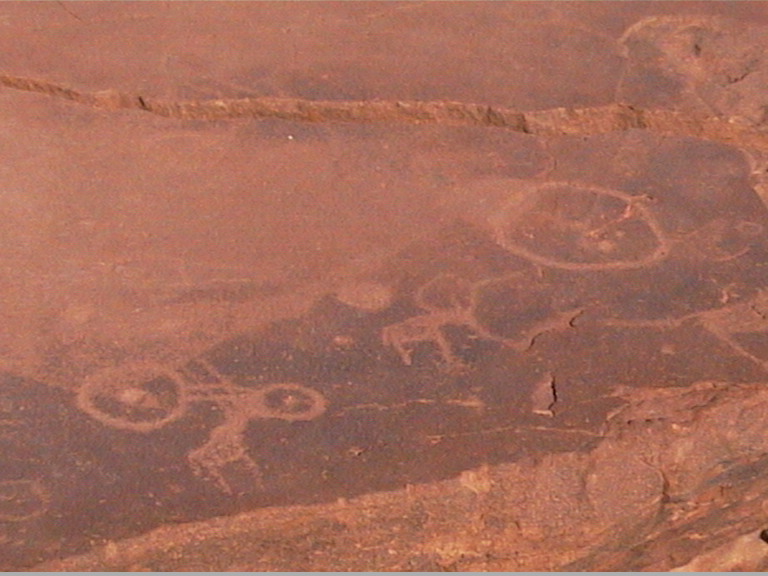Namibia: Landschaft
Tiere Himba Djemba Lodges
Mineralien
Felszeichnungen
Sossusvlei Naukluft
Cessnaflug Gemälde
zurück
Felszeichnungen bei Twyfelfountain
 |
Rockpaintings |
| Weg zu den
Wasserlöchern Landkarte der San Tierspuren Rockpaintings
|
|
Felszeichnungen
Twyfelfountein wyfelfontein
‚zweifelhafte Quelle Region Kunene in Namibia
Graulärmvogel
Namibia Mokuti Lodge Blessbock mokutietoshalodge.com Mokuti Lodge Mokuti Etosha
Lodge Mokuti Etosha Lodge in Namibia mokutietoshalodge.com Mokuti Lodge Mokuti
Etosha Lodge Mokuti Etosha Lodge in Namibia Namib Naukluft Lodge
Twyfelfountein Mountainlodge
von Info-namibia.com UNESCO
Weltkulturerbe und einzigartige Felsgravuren
Twyfelfontein, das übersetzt zweifelhafte
Quelle oder auch Quelle des Zweifels bedeutet, ist der Name einer Quelle und
eines Tales im Damara-Bergland, etwa 70 km westlich von Khorixas. Das Tal wurde
von den Damara bewohnt, welche das Tal in ihrer Sprache Uri-Ais (springende
Quelle) nannten.
1947 ließen sich weiße Farmer in dem Tal
nieder, aber die Quelle erwies sich als unzuverlässig und brachte nur wenig
Ertrag. Im Zuge des Odendaal Plans (Umsiedlung der einheimischen Bevölkerung in
Homelands) wurde die Farm im Jahre 1964 wieder aufgegeben.
Twyfelfontein is a renowned
archaeological and cultural site located in the
Damaraland region of
northwestern Namibia. It is
famous for its ancient rock engravings
and paintings, which are considered one of the most important prehistoric art
collections in Africa. The site is also a UNESCO
World Heritage site due to its
significance in understanding the lives of early humans in southern Africa.
Key Features of Twyfelfontein:
-
Rock Art:
- Twyfelfontein contains over
2,500 rock engravings
and paintings spread
across an area of about 1.5
square kilometers. These artworks date back
6,000 to 10,000 years
and were created by early
hunter-gatherer societies.
- The rock engravings predominantly
depict animals that were important in the daily lives of the ancient
peoples, including elephants,
rhinos,
lions,
giraffes,
springboks, and
oryx. There are also
scenes of humans,
footprints, and
ritualistic symbols.
- The engravings are carved into the
sandstone rocks and
are thought to have had
spiritual and cultural significance for the people who created
them, possibly reflecting hunting magic, rituals, or spiritual beliefs.
-
Cultural and Historical
Significance:
- The artwork at Twyfelfontein is
believed to have been created by the
San people, also
known as the Bushmen,
who were the region's original inhabitants. They were skilled
hunter-gatherers and
used the rock engravings for storytelling, communication, and spiritual
practices.
- The petroglyphs (rock engravings)
are some of the most significant examples of
prehistoric rock art
in Africa, providing insight into the
lifestyle, beliefs,
and environment of ancient peoples.
-
Unique Geological Features:
- Twyfelfontein is set in a
rugged, desert landscape
with remarkable geological features, including
deep ravines,
rocky outcrops, and
unique formations. The red
sandstone rocks, combined with the ancient engravings, create a
striking and visually dramatic setting.
- The area is part of the
Namib Desert and
experiences extreme temperatures, with very hot summers and cooler
winters, making it a fascinating location both from a geological and
environmental standpoint.
-
UNESCO World Heritage Site:
- Twyfelfontein was designated a
UNESCO World Heritage Site
in 2007 due to the
exceptional value of the rock engravings and the
cultural significance
of the site. It is one of the largest and most significant rock art
sites in Africa.
- The site has been preserved and is
managed by the Twyfelfontein
Community, and visitors are encouraged to explore the site with
a knowledgeable guide who can explain the meanings behind the artwork
and provide context for the engravings.
-
Flora and Fauna:
- Despite its arid location,
Twyfelfontein is home to a number of
unique plant species
and wildlife. The
region is part of the
Damaraland ecosystem, which is home to desert-adapted animals,
including elephants,
lions, and
giraffes, which are
often seen in the surrounding area.
- The landscape also features
interesting plant life, such as the
Welwitschia mirabilis,
a prehistoric plant species found in the area, which can survive for
thousands of years in harsh desert conditions.
Visiting Twyfelfontein:
-
Best Time to Visit: The
best time to visit Twyfelfontein is during the
cooler months, which are
generally from May to October,
when temperatures are more manageable. The summer months (November to March)
can be extremely hot and uncomfortable for touring.
-
Getting There:
Twyfelfontein is located about 40
kilometers south of the town of Khorixas and can be accessed by
car or
guided tours. Many
visitors combine a trip to Twyfelfontein with visits to other nearby
attractions such as Brandberg
Mountain or Damara Living
Museum.
-
Guided Tours: To fully
appreciate the history and significance of the site, visitors are encouraged
to take a guided tour, as
guides provide detailed explanations of the artwork and the history behind
the engravings.
Conclusion:
Twyfelfontein is an incredible testament to the ingenuity and creativity of the
ancient peoples who once inhabited the area. Its rich
cultural heritage, striking
natural beauty, and remarkable rock
art make it one of the must-see attractions in
Namibia. Whether you're a
history enthusiast, a lover of art, or just curious about Namibia's heritage,
Twyfelfontein offers a fascinating glimpse into the past.
 23.11.25 Copyright Dirk
Rauschenbach Koelnerstrasse 293 51702 Bergneustadt
Datenschutzerklaerung 02261 9788972 Mail ccooly(
at) web.de
23.11.25 Copyright Dirk
Rauschenbach Koelnerstrasse 293 51702 Bergneustadt
Datenschutzerklaerung 02261 9788972 Mail ccooly(
at) web.de
 Safaris
Bergsteigen
Wandern
Inselwandern Weltweit
Safaris
Bergsteigen
Wandern
Inselwandern Weltweit
 Europa
Inselwandern
Europa
Inselwandern
 Städtewandern
Städtewandern
 Paintings
Paintings  Dirk Rauschenbach
Dirk Rauschenbach
 Safaris
Bergsteigen
Wandern
Inselwandern Weltweit
Safaris
Bergsteigen
Wandern
Inselwandern Weltweit
 Europa
Inselwandern
Europa
Inselwandern
 Städtewandern
Städtewandern
 Paintings
Paintings  Dirk Rauschenbach
Dirk Rauschenbach
![]() 23.11.25 Copyright Dirk
Rauschenbach Koelnerstrasse 293 51702 Bergneustadt
Datenschutzerklaerung 02261 9788972 Mail ccooly(
at) web.de
23.11.25 Copyright Dirk
Rauschenbach Koelnerstrasse 293 51702 Bergneustadt
Datenschutzerklaerung 02261 9788972 Mail ccooly(
at) web.de